Gambians Are Sending Big Money Home: Changing Lives and Government
- $1.4 billion in transfers to the country between 2009 and 2018
- $245 million in remittances received by households in 2018 (15% of GDP)
- 122, 310 households are receiving remittances on a monthly basis
- More than $100,000 in funding to the opposition that ousted Jammeh in 2016
- Country’s total stock of emigrants is 89, 639 – main destinations: United States, Spain, the UK and Northern Ireland, Sweden, Germany
 Remittances to low- and middle-income countries reached a record $529 billion in 2018, according to the World Bank (Photo by Mass Njie).
Remittances to low- and middle-income countries reached a record $529 billion in 2018, according to the World Bank (Photo by Mass Njie).
By Modou S. Joof
Ebrima Jallow, 47, sits on a smooth, cozy sofa in shiny-red leather coatings in his parlour in Latrikunda German, a suburb of Gambia’s largest town, Serekunda, about 14 kilometers from Banjul, the capital.
The sitting room of his luxury self-contained house of five bedrooms is furnished with sofas, chairs, tables, a cupboard and a 49-inch flat Hitachi TV set fitted onto the walls; the ceiling is made of shiny red timber.
“All of the furniture in here is imported from the United States,” he said. Up until 2017, he and his wife together with their five children and his aging mother lived in poor housing conditions. They had electricity supply and running water but without flush toilets. They had two pit-latrines.
In 2016, two of his elder brothers (one in the United States and another in France) decided to build a better and bigger house for the family, investing up to D2 million (more than $42,000) in remittances to this cause.
“If it was not for the money my brothers sent from America and France, I wouldn’t have been able to build this house on my own even in 40 years,” said Jallow, a former guard at G4S Security Company, a global security solutions group, which operates in 98 countries.
“I was never going to make it; life would have been very difficult,” he said, having worked for 10 years as a security guard between 1996 and 2006. “I used to earn D1,500 [a little over $30] per month which is not enough to take care of the bills and other household needs.”
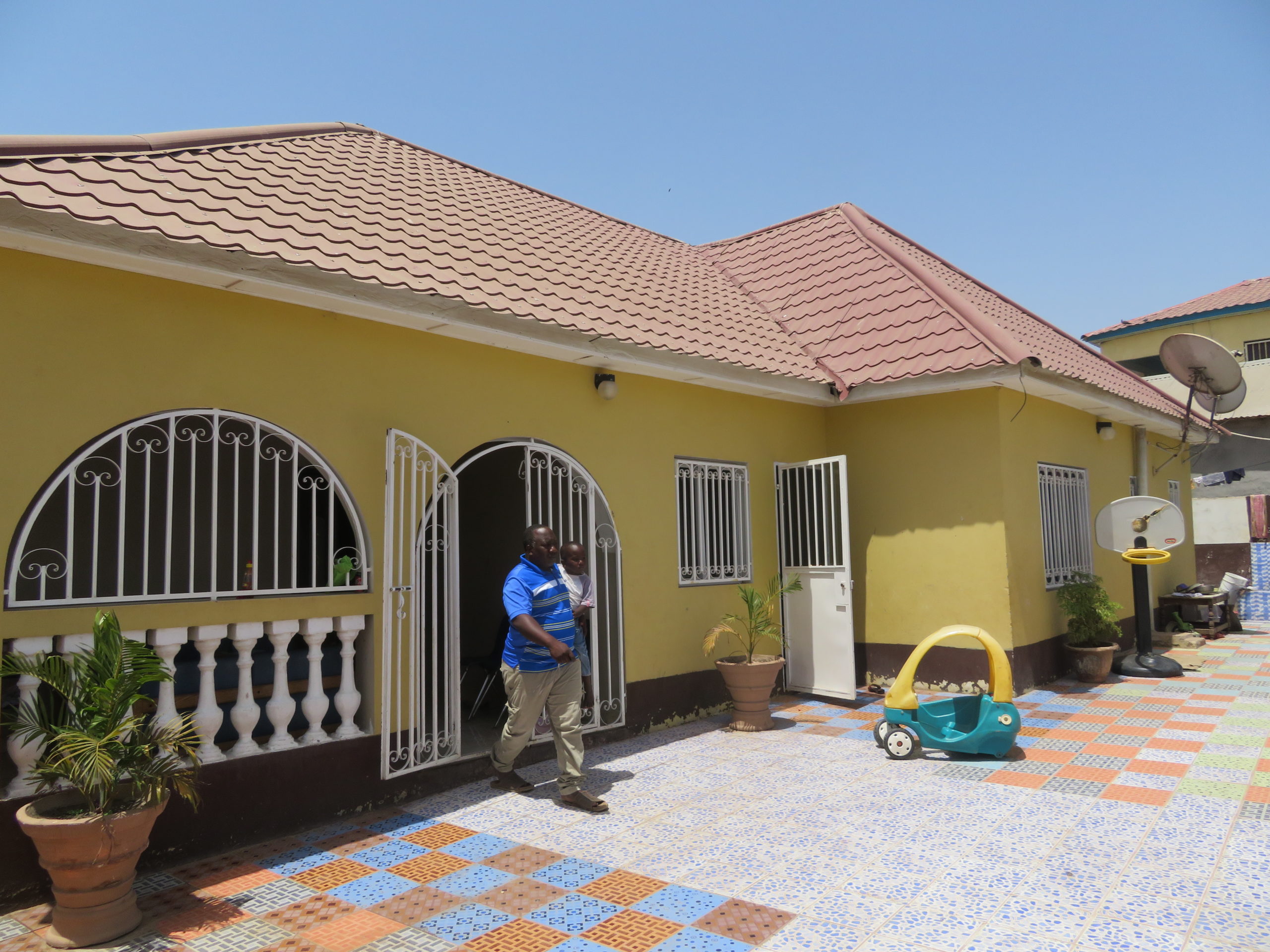
Jallow’s family is among 122, 310 households in The Gambia that are directly benefiting from money transferred from relatives abroad.
Of 280, 659 households in The Gambia, 36 percent received remittances as of 2017 either from a member of the household or another individual outside of the household, according to the Integrated Household Survey, a government study, released in October 2017.
Migrant remittances are recognised to be a significant channel through which Gambians in the diaspora contribute to local development and poverty alleviation.
In recent years, remittances surpassed foreign direct investment as the biggest source of financial inflow to the West African country – becoming one of the largest sources of foreign exchange for the country.
Jallow’s brothers [a computer expert in the U.S. and a carpenter in France] have been sending transfers home on a monthly basis over the years to meet the cost of basic needs like food, water, electricity, healthcare and school bills.
They have helped him establish a business, Gamway Enterprise, an import and clearing agency, on which his family’s livelihood is now dependent, and have bought him a Ford Edge Limited car worth D1.5 million (about $40, 000) to ease his movements and business dealings.
“My brothers regularly ship containers of goods on behalf of other Gambians, which I clear at the ports for onward distribution,” he said.
“I use the proceeds to pay for my children’s education, their healthcare needs, feeding, water and electricity, and buy fuel for my car,” said Jallow, who was awarded the “Best Parent” in 2016 by a primary school for meeting his children’s education fees on time and regularly checking with teachers how they are faring.
His brothers continue to send money for food. “Monies sent by relatives abroad are helping a lot of people like me,” he said.
Largest Recipients
Remittances to low- and middle-income countries reached a record high $529 billion in 2018, an increase of 9.6 percent over the previous record of $483 billion in 2017, according to the World Bank’s latest Migration and Development Brief.
Global remittances, which include flows to high-income countries, reached $689 billion in 2018, up from $633 billion in 2017, while transfers to Sub-Saharan Africa grew almost 10 percent to $46 billion in 2018. This is supported by strong economic conditions in high-income economies, the Bank said.
In 2018, The Gambia received $245 million (more than D11.5 billion) in remittances to Sub-Saharan African countries – representing 15.3 percent of the country’s gross domestic product (GDP) – an increase of $17 million from the 2017 figure of $228 million.

The World Bank said The Gambia is the second largest recipient of remittances as a share of GDP in Sub-Saharan Africa, only behind Comoros and ahead of Senegal, Ghana, and Nigeria – whose $24.3 billion remittance inflow is only 6.1% of GDP.
While this new development shows a 5% increase in remittance to GDP from 10% in 2012, the remittance inflow to The Gambia is bigger than the country’s entire export in 2018 which stands at $91.62 million.
According to the United Nations Department of Economic and Social Affairs, Gambia’s total stock of emigrants was 89, 639 in 2015, with the United States, Spain, the UK and Northern Ireland, Sweden, and Germany among main destination countries.
Remittances provide basic necessities for hundreds of thousands of families in The Gambia to meet cost of living, and it also creates thousands of jobs in the construction industry every year.
“The Gambia is at the developmental stage to harness the full potentials of remittances,” former Central Bank Governor Amadou Colley has said. “Most of the remittances flows are channeled into consumption but it also plays a significant role in housing financing and a key driver of sectors such as wholesale and retail trade. Most of the investments in the real estate sector are done by Gambians in the diaspora.”
Want to Leave
Thousands of young Gambians leave the country every year for Europe through deadly deserts and high seas. Over 8000 Gambians arrived in Europe in 2017, making the top five nationalities crossing the Mediterranean alongside Nigerian, Guinean, Pakistani, and Bangladeshi nationals, according to a [migrants] Flow Monitoring Survey published by the International Organisation for Migration (IOM) in February 2018.
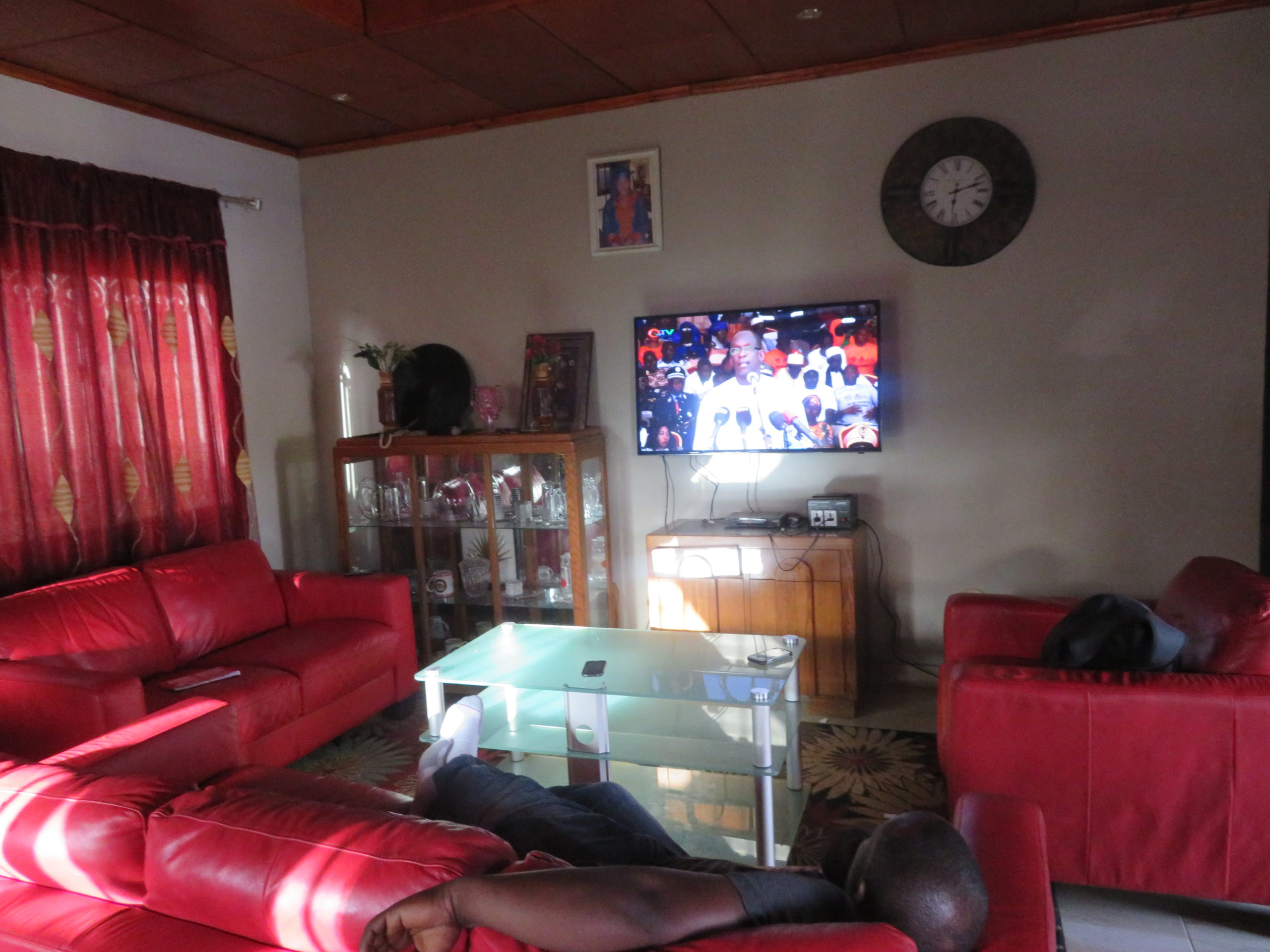
Those in pursuit of socioeconomic advancement are mainly youths. Figures from Gambia’s Immigration Department indicated that for the more than five thousand Gambians who arrived in Italy in rickety boats via the Mediterranean Sea in 2017 – about one thousand five hundred were unaccompanied children.
Today, a lot more are still willing to leave. The latest study released in March this year by the pan-African research network, the Afrobarometer, stated that there are a good number of Gambians who actually thought of leaving (up to 56%) of the population. The Gambia is among the top three countries alongside Cabo Verde (57%) and Sierra Leone (57%) whose young and educated thought of emigrating.
Nearly half of the country’s 2.3 million people are poor, and are living below $1.25 a day. In recent years, a brutal dictatorship under former President Yahya Jammeh pushed several thousand people into fleeing. Many others also fled The Gambia to look for better economic opportunities abroad.
Ebrima Bittaye, 22, a carpenter in Latrikunda German who repairs wooden sofas, said he wants to leave. “I believe there are greater opportunities for me out there. I want to be able to build a better house for my mother, build my own house, and help her live a better life,” he said in an interview.
Between 2010 and 2014, more than 500 Gambian migrants have died while trying to reach Europe through irregular means, according to The Gambia government.
Bittaye said he was aware of the risks involved in trying to reach Europe through irregular means, but he is undeterred. “I know. But a lot of people, a good number of them, my age mates, have succeeded in reaching Europe through the ‘back-way’ [the name Gambians use to refer to irregular migration],” he said. “I do not think about the dangers, all I do is pray to God to make it easy for me to reach Europe in peace.”
The numbers of people fleeing poverty or persecution have generally reduced but migrants are still going to Europe via deserts and the Mediterranean, though prospects of having asylum now appears slim since the fall of ex-president Yahya Jammeh.
According to the EU border and coast guard agency, Frontex, the number of migrants arriving in Italy through Libya between January and September 2017 fell by 13 percent to 99, 800 with Nigerians and Guineans making up the largest number.
On the Western Mediterranean, though with a significantly smaller number compared to the figures above, the number of detections of illegal border crossings into Spain by both sea and land reached 13, 600. This figure is nearly three times higher than that of 2016, and the most migrants detected on this route in 2017 are from Morocco, Ivory Coast and The Gambia. In the first quarter of 2019, the total number of irregular migrants using this route has reached 5,450.
But European governments are pushing them to go back home by funding development projects in countries of origin. An 11 million euro Youth Empowerment Project (YEP) funded by the European Union’s Emergency Trust Fund for Africa (EUTF), is helping build skills for returning and would-be migrants on entrepreneurship, and other trades like preparing them for work in the hospitality industry.
The YEP has so far supported about 3, 600 young Gambians on entrepreneurship, access to finance, and skills development, and have supported 400 youth-led small and medium enterprises on improving product development, quality, food safety standards, increasing production, and marketing.
However, Bittaye said such an initiative is not enough to keep him at home. “A plot of land of 20 x 25 meters cost up to D300, 000 ($6, 382). What sort of small business can I run here that would generate enough for me to be able to change my family’s condition and at the same time 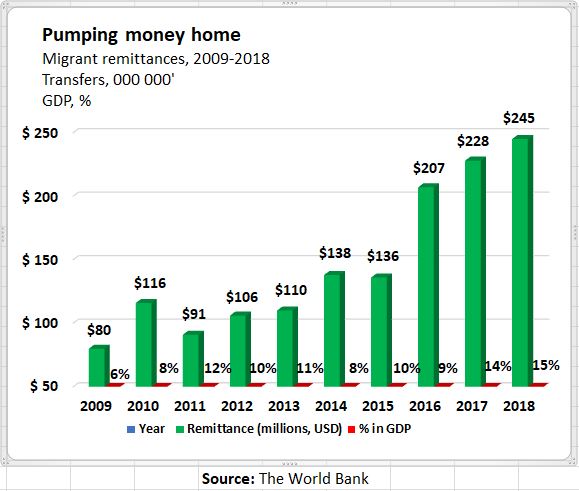 be able to sustain that business?” he asked.
be able to sustain that business?” he asked.
“I can never earn enough here to make the change I want in the family, we are poor and living conditions are not so good here,” said Bittaye, the third born in a family of five siblings. “I am saving money as part of my preparations. I have a skill as a carpenter and I believe I would be able to secure a job once I reach Europe. My skills will be better utilized there.”
In order to tackle this notion among young Gambians that the grass is greener in Europe, YEP is now providing a platform for highly-skilled and successful professional Gambians in the diaspora to be able to contribute to the development of their country beyond sending money.
“There is an incredible pool of talented and knowledgeable Gambians in the diaspora, so we have a number of programmes, one of them is Leadership Gambia, through which Gambians abroad help young entrepreneurs at home to connect to market and run successful businesses,” Raimund Moser, manager of YEP, said in an interview.
“In this way, diaspora Gambians can contribute to nation building, private sector development in particular, and not just sending back money for subsistence or for naming ceremonies or building a house.”
Ordered to Leave
In April 2019, the EU and GIZ International Services launched the ‘Tekki fii’ (‘Make it here’ in Gambia), a three year project intended to boost economic development with a focus on attractive employment and revenue generation in regions prone to migration.
It is hoped that the Tekki fii will promote a favourable social and economic environment, ensure effective and sustainable reintegration [of returning migrants], and to improve the attractiveness of rural areas.
The project is meant to create employment for youths and to support youth-led small-enterprises in two ways – by providing technical skills training, and business development.
“The idea behind the Tekki fii project is that we are not saying that people should stay in The Gambia, but if you want to go to another country to live and work, then you need to make sure that you have access to their job markets,” Moser said.
“But if you go through the ‘back way’, through irregular means, you won’t be able to perform any economic activity. You will not be able to find a job, be able to integrate in society and live a decent life. So we need to really create alternative ways for these young talents to fulfill their dreams and follow their perspectives here in The Gambia.”
Several Gambian migrants whose asylum requests have been refused are being lined up for deportation. Germany, for example, has started deporting in small numbers, the 1, 750 Gambian migrants whose asylum requests are refused.
More than 14, 000 Gambians who are found to be illegally present in EU-member states (having entered illegally or overstayed their permits or have their asylum requests refused) have been ordered to leave, according to figures provided via email by the statistical office of the EU, Eurostat.
But some migrants are also returning due to difficult conditions (jail and torture) they suffered in Libyan prisons or detention centers.
In February this year, 3, 668 Gambians returned home under the EU-IOM joint initiative for migrant protection and reintegration – most of them were returned from Libya and Niger, while a small number returned from Mali, Morocco, Mauritania and Tunisia.
Rising Unemployment
According to IOM’s Flow Monitoring Survey 2018, more than 30% of migrants from Gambia, Bangladesh, Nigeria, Guinea, and Pakistan who are crossing into Europe reported being unemployed at the time of departure.
“The highest share of unemployed individuals was noticed among Gambian respondents, with 38% of them having reported being unemployed at the time of departure, followed by Bangladeshis (35%), Nigerians (30%), Guineans (27%), and Pakistanis (27%),” the report stated.
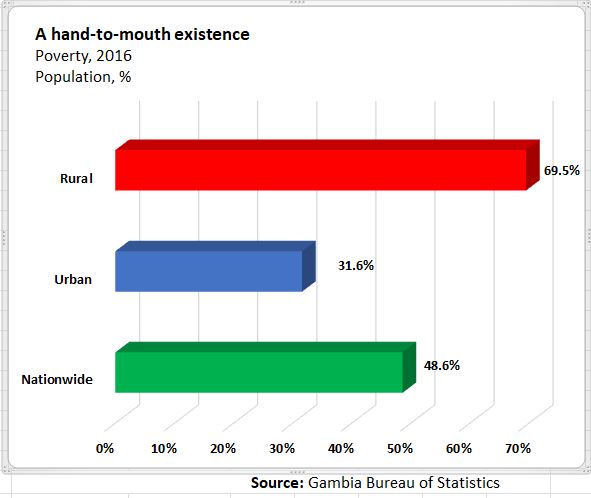 Gambia’s former president, Yahya Jammeh, left the country in 2017 with an “economy completely destroyed”, and with a debt of D48.3 billion (more than $1 billion), according to the government.
Gambia’s former president, Yahya Jammeh, left the country in 2017 with an “economy completely destroyed”, and with a debt of D48.3 billion (more than $1 billion), according to the government.
Jammeh is also said to have stolen up to $359 million (more than D16 billion) from government coffers during his rule of more than two decades, according to an inquiry into his financial affairs. Nonetheless, the economy grew by 6.8 percent in 2018 from 4.6 percent in 2017 mainly due to growth in agriculture and tourism sectors.
But the country’s domestic debt increased in May 2019 to D31.8 billion ($676, 595 million) which is 41.9 percent of GDP – from D31.2 billion ($663, 829) – which represented 39.2 percent of GDP a year ago.
“The high level of public debt remains a risk to the overall macroeconomic stability,” Central Bank Governor Bakary Jammeh said in a statement.
Unemployment is still very high at 35.2 percent (about 240,000 people) from a population of 2.3 million, and poverty remains at nearly 50 percent – with one in every four Gambians in rural areas living in extreme poverty, according to The Gambia Bureau of Statistics (GBoS).
The country’s latest Labour Force Survey (LFS) shows that the unemployment rate has increased in 2018 by 6% from 29.2 percent in 2012. Those unemployed are men and women between the ages 15 and 64.
A good number of men (46.7%) and women (52.4%) between 15 and 64 years are discouraged job seekers. These unemployed persons are not seeking job because they feel that they lack proper qualifications, or that there is no suitable work available, according to the LFS 2018. And even whereas people are able to find jobs, salaries are as low as D1500 ($31) a month – the cost of a bag of rice.
However, a good number of the unemployed have in one way or the other benefitted from remittances as transfers are made home monthly by family members abroad. Between 2009 and 2018, The Gambia recorded more than $1.4 billion in remittances inflow – this figure equals the amount of money the government raised at a donor conference in Brussels in May last year.
Matching Jammeh’s Financial Power
In 2016, Gambians in the diaspora raised $102, 359 (D4.8 million) for the opposition coalition that successfully dislodged the long-time autocrat in the presidential elections.
For the first time, the opposition was financially strong to mount a true and vigorous challenge to Jammeh’s rule with well-financed nationwide campaigns and was able to secure the services of volunteers as polling staff in various voting and counting centers across the country.
In 1996, Jammeh held and won elections after seizing power as a 29-year-old army officer. He also won three more elections in 2001, 2006 and 2011 – most of them widely criticized.
His success at the polls was supported by an unlevelled political playing field that gives much advantage to incumbency – access to and use of state resources and being bankrolled by state parastatals.
However, diaspora transfers enabled the opposition to match Jammeh’s election campaign finances for the first time and eventually defeated him in the December 2016 polls.
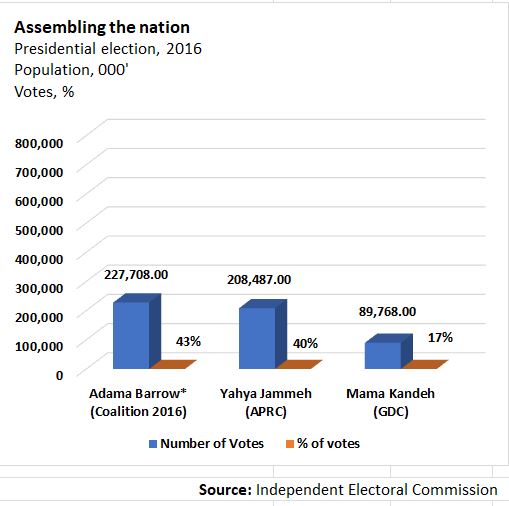 “Our political activities (the convention, nomination and campaign) were well funded by Gambians in the diaspora and some other Gambians who are based in the country,” Musa Sonko, Coalition 2016 Executive Member, said in an interview.
“Our political activities (the convention, nomination and campaign) were well funded by Gambians in the diaspora and some other Gambians who are based in the country,” Musa Sonko, Coalition 2016 Executive Member, said in an interview.
“That is why we were able to match Jammeh in all areas: if he printed 1000 t-shirts, we were able to print 2000 and everything that he did we did twice more. This was possible because of the monies we received from Gambians in the diaspora and some ‘concerned’ Gambians in The Gambia who do not wish to be named.”
The Coalition spent close to D10 million in the 2016 presidential election, and a good share of this amount came from Gambians abroad, Sonko said.
Jammeh’s subsequent refusal to leave office plunged the country into a month-long political crisis before he was forced to step-down by military threats from West African leaders. Since attaining independence from Britain in 1965, The Gambia has yet to see a smooth transfer of power.
Commenting generally, Sonko said remittances are so important to The Gambia because people are resource-constrained and cannot develop themselves.
“Those who may consider themselves as the unfortunate ones are those who don’t have anybody to remit anything to them. Our survival is entirely dependent on the monies sent by relatives abroad. Remittance is the key to our survival now,” he said.
Home to 2.3 million people, The Gambia is one of the world’s poorest countries, with a gross national income per capita of $680. It is surrounded by Senegal aside from its access to the Atlantic Ocean.
The author, Modou S. Joof, is a freelance journalist, and the Banjul-based correspondent for Bloomberg; Graphic photo by Mass Njie, a Graphics Designer at the Gambia Press Union; and Chart illustrations by Buba Fatty, an Accountant at the Gambia Press Union.


Comments are closed.